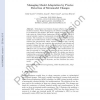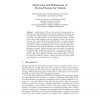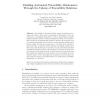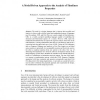ECMDAFA
2009
Springer
14 years 28 days ago
2009
Springer
Technological and business changes influence the evolution of software systems. When this happens, the software artifacts may need to be adapted to the changes. This need is rapidl...
ECMDAFA
2009
Springer
14 years 28 days ago
2009
Springer
Textual Syntax (TS) as a form of model representation has made its way to the Model-Driven Software Development community and is considered a viable alternative to graphical repres...
ECMDAFA
2009
Springer
14 years 28 days ago
2009
Springer
Domain-specific modeling solutions have been promoted for some time in order to improve the productivity of software developers by providing them with modeling environments that ar...
ECMDAFA
2009
Springer
14 years 6 months ago
2009
Springer
Abstract. Traceability is demanded within mature development processes and offers a wide range of advantages. Nevertheless, there are deterrents to establishing traceability: it c...
ECMDAFA
2009
Springer
14 years 7 months ago
2009
Springer
Model-driven engineering techniques can be used both to create new software and to modernize existing software systems. Modeldriven software modernization requires a first step for...
ECMDAFA
2009
Springer
14 years 9 months ago
2009
Springer
The need for a design language that is rigorous but accessible and intuitive is often at odds with the formal and mathematical nature of languages used for analysis. UML and Petri ...
ECMDAFA
2009
Springer
14 years 9 months ago
2009
Springer
Model Driven Software Development (MDSD) has matured over the last few years and is now becoming an established technology. Models are used in various contexts, where the possibili...
ECMDAFA
2009
Springer
14 years 9 months ago
2009
Springer
The size and the number of models is drastically increasing, preventing organizations from fully exploiting Model Driven Engineering benefits. Regarding this problem of scalabilit...
ECMDAFA
2009
Springer
14 years 9 months ago
2009
Springer
ECMDAFA
2009
Springer
14 years 9 months ago
2009
Springer
Abstract. Guidelines and consistency rules of UML are used to control the degrees of freedom provided by the language to prevent faults. Guidelines are used in specific domains (e...




